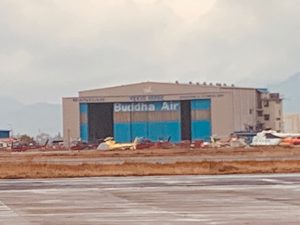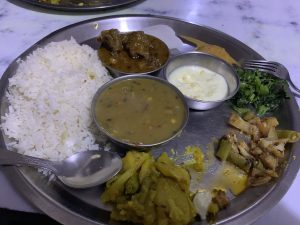Enlightenment in the Kathmandu Valley
Wellbeing insights from Kathmandu, Nepal:
• Understanding Nepalese Culture: Meeting truly genuine and humble people who do their best and stay happy on the journey.
• Entrepreneurship: Focusing on the environment and betterment for all.
• Perspective: Hearing about the caste system and realizing how lucky we are in the USA to have an equal opportunity framework (in theory).
First encounters in Kathmandu
As I walked down the stairs after landing in Kathmandu, I looked back across the runway towards the mountains blanketed in fog and saw a blue hanger with the words “Buddha Air” written above. I took a deep breath and felt the oxygen brush over the tip of my nose, just like any good meditator would. I thought to myself, “I’m in the Himalayas, the land of the Buddha” and immediately knew there was nothing to fear.

I’d just spent a week alone in Chengdu and was looking forward to the company of my new buddy and videographer, Dan. This would be the first time we were traveling together and I was psyched to have someone join me on this new project.
The baggage claim area was filled with Europeans and Chinese waiting to claim their hiking gear while the airport workers were dressed in branded outdoor clothing from North Face and Arc’teryx. I felt like we’d flown into a mountaineering expedition sponsored by Western companies.
I strolled over to the Forex counter to exchange some Renminbi. “Are you hiking?” asked the clerk. I nodded. “It’s beautiful and peaceful in the mountains,” he replied. “That’s Nepal – please find peace”, as if he knew the reason I was there.
I was worried about being constantly hustled in Nepal but was soon to realize that it wasn’t their trait. A pre-booked $7 taxi whisked me through the residential outskirts of Kathmandu, passing crumbling brick buildings and motorbikes flying in every direction. As we approached the center of the city, shops sporting hiking brand names began to appear, with both real and knock-off gear. There was even a local brand – Kaemp – that was very good quality. I realized that you needn’t bring any trekking gear to Nepal as you can buy everything there, even the knock-offs are good for a week of hiking.
In addition to hiking gear, there were plenty of trekking agencies – 1,400 to be exact! After meeting up with Dan (who was just as pumped to be in Nepal as I was), we chatted with a few operators and settled on Adventure Nepal (http://www.advnepaltrekking.com/). The owner was originally a porter/guide, with a British/Australian-fused accent.
We spent around an hour discussing whether to do Everest Base Camp or the Annapurna Circuit, eventually deciding to go with Everest. He warned us that it would be cold…really cold. “But here’s a picture of some 60-year-old guys who did it last week,” he said before letting out a bellowing laugh. “You’ll be fine!” We celebrated with a plate of fresh dumplings known as momos – one of Nepal’s most delicious culinary offerings, if you can call it that.
Wandering around the streets of Thamel, we stopped in at some of the hiking gear shops. Rather than hustling, the owners simply gave their pitch and left you to decide, which was refreshing after the scams I’d experienced in other places. Only once did we experience something that seemed at odds when a group of women with children hustled us to buy imported condensed milk priced at $20 for their babies. I asked the store owner if they came in often and he confirmed what I thought, silently nodding when I said: “this must be a trick”.
As we left the main tourist area, the streets thinned out and we could see the damage that remained from the earthquake in 2015. Bakeries, momo shops and temples competed for space with guys pushing street food carts while open bathing and washing areas were tucked in behind. The old Asan bazaar was an experience in itself, with the crowded streets heaving with locals buying and eating – the commotion gave me a headache! Check out the video above.
We ate dal bhat (steamed rice, cooked lentil soup and assorted curries/condiments) and momos almost every day, as well as “sizzlers” – a plate of noodles topped with meat, vegetables and gravy. I loved it but Dan…not so much – it didn’t settle well in his stomach. There are plenty of decent tourist restaurants in Thamel (as well as cheap hostels and hotels), with Or2k becoming our go-to joint, alongside most of Kathmandu’s western visitors.

East to Bhaktapur
We took a day trip to Bhaktapur, a historic city that lies just under an hour’s drive east of Kathmandu. Our trip coincided with a festival focused on education, with youngsters about to enter school being blessed and covered in the smoke of incense before sitting down in long rows for a shared meal. As we passed a crowded corner, we saw a stream running red – the blood flowing from a slaughtered bull that had been sacrificed for the gods.
Bhaktapur was clustered with temples, one of which showed 24 different sexual positions. While people don’t speak openly about sex (and covering in traditional gowns is the accepted norm), the temple was created several hundred years ago to educate people about procreation during a period of population decline.
While many Nepalese were striving to maintain their traditions in the face of globalization, the younger generations were succumbing to modern influences from the west. Many were walking the streets with cell phones as their parents wouldn’t permit them inside the house. Our guide explained that the town still followed a caste system and used his own experience of marrying a woman from a lower caste, despite his family’s disapproval. Even now his mother refused to cook special meals for his wife.
He told us about his inability to finish medical school due to a lack of money, which is why he ended up in the tourism industry. Apparently, the upper castes could access free education if they needed while those in the lower castes had to struggle to advance in life. Despite the obvious challenges he’d faced, he wasn’t defeated and expressed the acceptance that I was soon to discover was a trait of the Nepalese. They will reach for their dreams but also accept what happens because so much is beyond their control.
Entrepreneurship and volunteer opportunities
Before we ventured off trekking to Everest Base Camp, we wanted to connect with a local volunteer organization to tee up some teaching engagements. I stumbled across Nepal Communitere (https://nepal.communitere.org/), an innovation hub that operates a Makerspace out of a few shipping containers on the outskirts of the city.
We jumped in a taxi, only to be kicked out about a mile down the road where a taxi strike blockade was in place, with masked dancers followed by people singing and dancing. To see how they strike in Nepal, check out the video {here}. Back on a bus, we managed to negotiate our way to the Nepal Communitere headquarters – thank god for Google Maps!
The organization was run by Anita (who’d studied in the U.S.A), Anil (who completes a cross-country bike trip every year), Bahar and Padmakashi. They were welcoming and set us up to meet around 10 different companies, ranging from an e-rickshaw startup to a business specializing in drone 3D imaging and another in creating recycled paper from elephant dung.
As always, working with companies like this was inspirational and exciting. What I enjoyed most was the creativity of the entrepreneurs in finding environmentally friendly solutions to keep Nepal as clean and pristine as possible. It again reinforced the Nepalese trait of doing one’s best and keeping a positive attitude – something that resonated with me throughout my journey and deep into the mountains of Everest.
There are lots of ways you can volunteer in Nepal, including post-earthquake rebuilding projects and helping to combat sex trafficking. For more inspiration, check out this list of projects and pre-vetted volunteering opportunities. See the list here.
